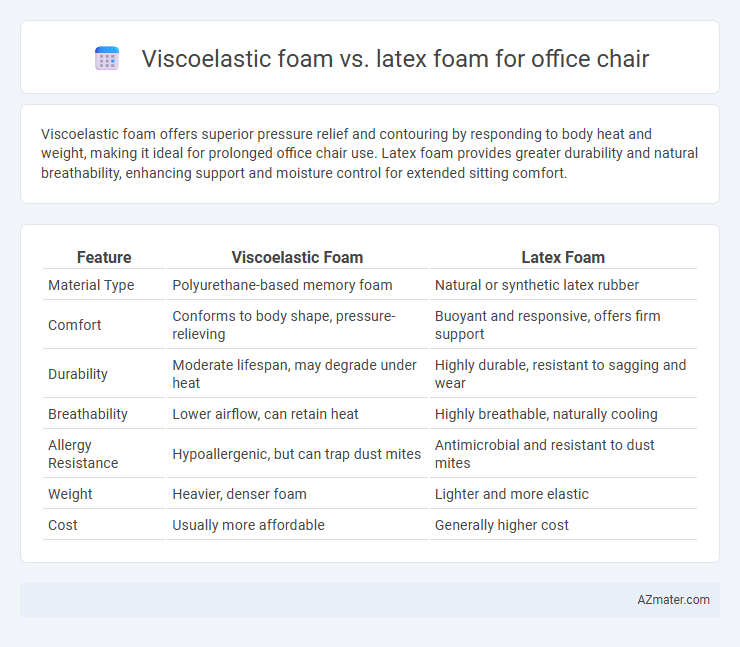Viscoelastic foam offers superior pressure relief and contouring by responding to body heat and weight, making it ideal for prolonged office chair use. Latex foam provides greater durability and natural breathability, enhancing support and moisture control for extended sitting comfort.
Table of Comparison
| Feature | Viscoelastic Foam | Latex Foam |
|---|---|---|
| Material Type | Polyurethane-based memory foam | Natural or synthetic latex rubber |
| Comfort | Conforms to body shape, pressure-relieving | Buoyant and responsive, offers firm support |
| Durability | Moderate lifespan, may degrade under heat | Highly durable, resistant to sagging and wear |
| Breathability | Lower airflow, can retain heat | Highly breathable, naturally cooling |
| Allergy Resistance | Hypoallergenic, but can trap dust mites | Antimicrobial and resistant to dust mites |
| Weight | Heavier, denser foam | Lighter and more elastic |
| Cost | Usually more affordable | Generally higher cost |
Introduction to Viscoelastic and Latex Foams
Viscoelastic foam, commonly known as memory foam, is polyurethane foam that adapts to body heat and pressure, providing personalized support and pressure relief ideal for office chairs. Latex foam, derived from natural or synthetic rubber, offers a resilient and breathable seating surface with durable elasticity and excellent lumbar support. Both materials improve comfort and ergonomics in office chairs but differ significantly in response time, durability, and breathability.
Composition and Material Properties
Viscoelastic foam, commonly known as memory foam, is composed of polyurethane with added chemicals to increase viscosity and density, providing excellent pressure relief and conforming support by responding to body heat and weight. Latex foam, derived from natural or synthetic rubber, offers higher resilience and breathability with a firm, supportive feel that retains its shape better over time due to its open-cell structure. The viscoelastic material excels in contouring and reducing pressure points, while latex foam provides superior durability, elasticity, and natural moisture-wicking properties ideal for prolonged office chair use.
Comfort and Support Differences
Viscoelastic foam, known for its pressure-relieving memory properties, contours closely to body shape, offering superior comfort and reducing stress on joints during long office hours. Latex foam provides a firmer, more resilient support with natural breathability, maintaining shape and promoting better posture by evenly distributing weight. Choosing between the two depends on preference for softness and moldability with viscoelastic foam or the durability and bounce-back support characteristic of latex foam.
Durability and Longevity
Viscoelastic foam, known for its slow response to pressure and excellent contouring abilities, tends to degrade faster under constant heavy use compared to latex foam, which offers superior resilience and maintains its shape over time. Latex foam's inherent natural elasticity provides enhanced durability, making it a preferred choice for office chairs that require long-lasting comfort and support. Office chairs with latex foam cushions typically exhibit better longevity, resisting sagging and indentations much longer than those with viscoelastic foam.
Breathability and Temperature Regulation
Viscoelastic foam, also known as memory foam, tends to retain heat due to its dense structure, making breathability and temperature regulation challenging during extended office chair use. Latex foam naturally offers superior breathability with its open-cell structure and inherent ventilation channels, promoting airflow and maintaining a cooler seating surface. For office chairs, latex foam is generally preferred when prioritizing breathability and effective temperature regulation over prolonged periods.
Pressure Relief and Ergonomics
Viscoelastic foam, also known as memory foam, offers superior pressure relief by contouring closely to body shape and evenly distributing weight, reducing pressure points during prolonged sitting. Latex foam provides excellent ergonomic support with a responsive and buoyant feel, promoting natural spinal alignment and enhanced airflow to prevent heat buildup. Both materials improve office chair comfort, but viscoelastic foam excels in pressure management while latex foam optimizes ergonomic support and durability.
Allergen Concerns and Hypoallergenic Features
Viscoelastic foam, commonly known as memory foam, is generally hypoallergenic due to its dense structure which resists dust mites and allergens, making it suitable for office chairs used by individuals with allergies. Latex foam, especially natural latex, offers strong antimicrobial and antifungal properties, reducing the risk of mold and allergen accumulation, while some synthetic latex variants may cause sensitivities in latex-allergic users. Both materials provide allergen concerns and hypoallergenic features, but natural latex foam is often preferred for its organic resistance to allergens, whereas viscoelastic foam excels in minimizing dust mite presence.
Environmental Impact and Sustainability
Viscoelastic foam, often made from petroleum-based polyurethane, has a higher environmental footprint due to non-renewable resource extraction and slower biodegradability compared to natural latex foam derived from rubber trees. Latex foam offers superior sustainability as it is biodegradable, renewable, and has a lower carbon footprint during production, making it a greener choice for eco-conscious office furniture. Manufacturing processes for latex typically involve fewer harmful chemicals and lower emissions, further enhancing its environmental credentials over viscoelastic foam.
Price Comparison and Value for Money
Viscoelastic foam office chairs typically cost less than latex foam models, with prices generally ranging from $100 to $300 compared to latex's $200 to $500. Viscoelastic foam offers excellent pressure relief and conforms closely to body contours, providing good value for ergonomic support at a lower price point. Latex foam is more durable and naturally hypoallergenic, justifying its higher cost for users seeking long-term investment and enhanced comfort.
Choosing the Right Foam for Your Office Chair
Viscoelastic foam offers superior pressure relief and conforms closely to body contours, enhancing comfort during long hours of sitting. Latex foam provides excellent durability, natural breathability, and responsive support, making it ideal for users who prefer a firmer seating experience. Choosing the right foam depends on prioritizing either contouring comfort with viscoelastic memory foam or resilience and breathability with latex foam for your office chair.

Infographic: Viscoelastic foam vs Latex foam for Office chair
 azmater.com
azmater.com